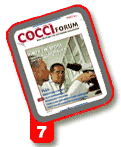COCCI Confidential
Vaccine Controls Coccidiosis, Improves Performance In Integrator's Controlled Study
Editor's note: The information for this article was provided by a major US
poultry company on the condition that its name and location be kept
confidential. The sources mentioned in the article have nevertheless
reviewed the information for technical accuracy and approved it for
publication in CocciForum. It is presented here in our newest feature, Cocci
Confidential, to help the poultry industry learn from these real-world experiences
and improve their management of coccidiosis. If you have a story you would like
to share with Cocci Confidential, please contact the editor at [email protected]
or call 508-627-6949 (US).
The veterinarian was still skeptical.
He wanted proof that vaccinating
broilers to prevent coccidiosis
wouldn't hurt performance.
His employer, a major poultry integrator
in the US processing millions of
birds annually, hadn't been vaccinating
against coccidiosis for long. Initially,
there were some performance irregularities,
but he couldn't ignore the numbers
from the third cycle "the results
were stellar.
A good study was needed, but comparing
a coccidiosis vaccine directly to
a feed-grade anticoccidial program
under true field conditions would be
difficult. Non-medicated feed would
have to be provided to houses with
vaccinated flocks; in particular, no
anticoccidials could be fed to vaccinated
birds "they could destroy the vaccine
oocysts that help build immunity
to coccidiosis.
Anticoccidial feed would have to be
delivered to other houses on the same
farms with unvaccinated birds. Care
would have to be taken to avoid manufacturing
or delivery errors for the life
of the flock. It would be a challenge for
a big and busy integrator, but data was
needed to determine whether changes
should be made to the standard coccidiosis
control program.
Study design
In the fall of 2002, a multi-farm, pairedhouse
trial was initiated. It involved
four, 4-house farms raising heavy broilers
(7.5 lbs). The integrator vaccinated
two houses on each farm with
Coccivac-B, a live-oocyst vaccine; in the
remaining houses, birds were fed an
anticoccidial shuttle utilizing narasin
and nicarbazin, which was the integrator's
standard program and served as
the study's control. Evaluations were
conducted on 156,000 birds from the
vaccinated group and on 156,000 birds
from the control group.
The ration formulation for the two
treatments was consistent except that
vaccinated birds received a virginiamycin
premix in the starter and finisher
ration and bacitracin methylene disalicylate
and roxarsone in the grower
ration, while controls received narasin,
nicarbazin and bacitracin methylene
disalicylate in the starter ration and
narasin and roxarsone in the grower
and finisher rations (Table 1).
Findings
At 4 weeks (28 days) and 7.5 weeks of
age (52 days), veterinarians from
Schering-Plough Animal Health and
Alpharma Inc. conducted posting sessions
on the 16 test houses, where they
looked for evidence of coccidialspecies. They used microscopic evaluation
for Eimeria maxima, since this
species does not always produce distinct
gross lesions and is more likely
than other Eimeria species to impair
feed conversion and weight gain. By 51
to 55 days of age, most of the lesions
received mild scores of +1 and +2
(Figures 1 and 2).
In addition, the integrator processed
birds from each treatment separately.
The processing plant reported standard
performance parameters such as the
percent livability, gross pounds sold,
average weight, feed conversion and
average daily gain (Table 2).
The results
Vaccinated birds and the controls
receiving feed-grade anticoccidials each
demonstrated mild coccidial lesions at 4
weeks of age. However, the lesions had
resolved by the second post-mortem
exam at 7.5 weeks of age (Figures 1
and 2). Vaccination did not appear to
affect either 7-day mortality or overall
livability compared to controls.
On a farm-by-farm basis, vaccinated
flocks outperformed or equaled the
performance of the control flocks for all
significant parameters. Vaccinated
flocks also demonstrated better performance
on an averaged basis.
Compared to flocks receiving standard
ionophores, those that were vaccinated
had:
"� An average weight 9.6 points higher
"� An average feed conversion 1.6
points lower
"� A caloric conversion 11 calories
lower
"� An adjusted caloric conversion 33
calories lower
"� A standard cost per pound 0.17
cents lower
Discussion & conclusion
Coccivac delivers a controlled, balanced
dose of sporulated or infective
oocysts of the economically significant
Eimeria species. A new generation
of oocysts develop in vaccinated birds
and are then excreted, providing reexposure
to Eimeria oocysts. The
process stimulates natural, long-lasting
immunity.
Generally, it takes about two to
three oocyst cycles for strong immunity
to develop. Vaccinated birds may be
presented with a field challenge from previous flocks before their immunity is
fully established, which explains why
performance results may seem irregular
with the first cycle of Coccivac-B.
In this rare multi-farm, paired-house
study, Coccivac-B was successfully
used for the long-term management of
coccidiosis without sacrificing performance.
In other words, Coccivac-B used
in real-world conditions not only controlled
coccidiosis, it improved broiler
performance compared to ionophore
anticoccidials.
Source: CocciForum Issue No.7, Schering-Plough Animal Health.







